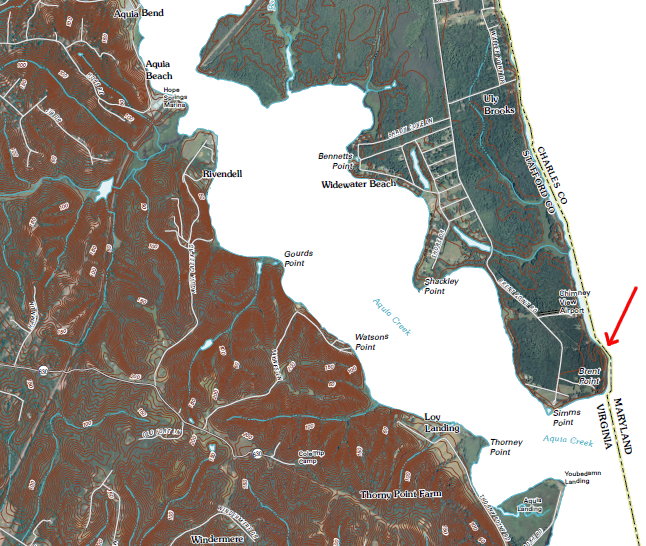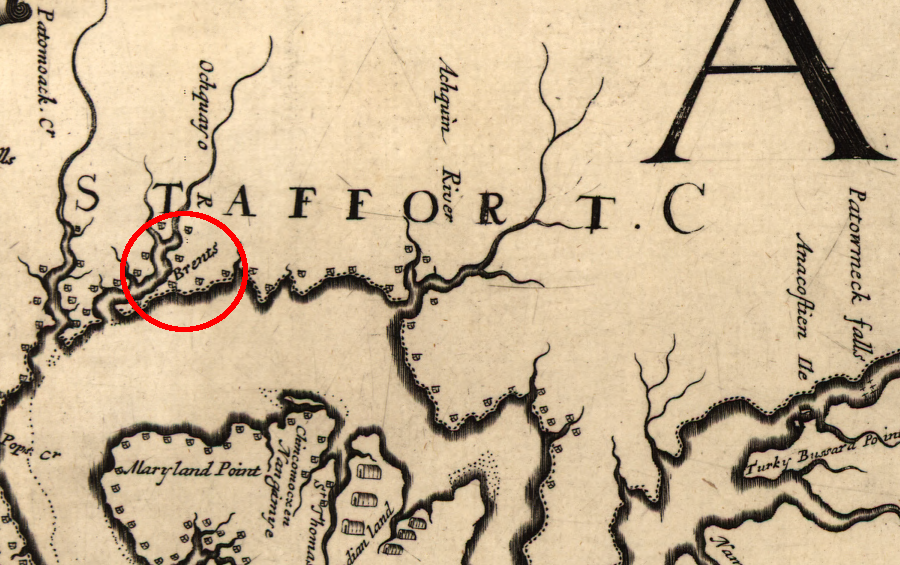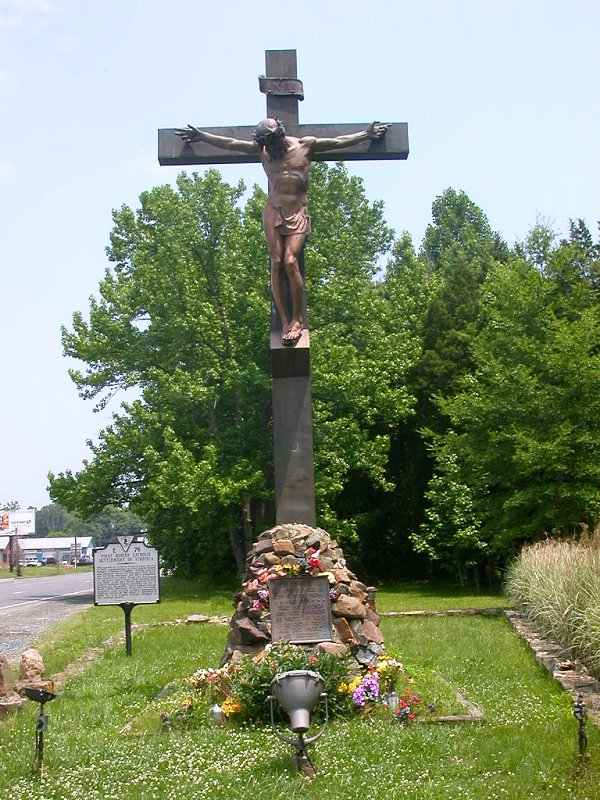
Brent Point, at southern tip of Widewater Peninsula in Stafford County
Source: US Geological Survey, Widewater 7.5 topo map (2011)

Brent Point, at southern tip of Widewater Peninsula in Stafford County
Source: US Geological Survey, Widewater 7.5 topo map (2011)
Four members of the Brent family chose to leave England and settle in Maryland in the 1630's. The family were Catholics, and as England headed towards its Civil War it was clear that economic opportunity and personal safety would be enhanced by crossing the Atlantic Ocean.
Fluke Brent returned to England, but his brother Giles and sisters Mary and Margaret became key members of the Maryland and then Virginia gentry. The sisters chose to stay single, a rare decision when men outnumbered women by 6:1. Staying single enabled them to manage their wealth independently. Had they married, their husbands would have automatically taken control of all business affairs for the family.
The political conflicts within Maryland were intense, with religious differences overlayed on economic and class rivalries. The colony had its own small-scale civil wars.
In 1645, Protestant ship captain Richard Ingle raided St. Mary's City and robbed the houses of Catholic leaders. He put Giles Brent and Jesuit priests in chains and transported them back to England:1
Lois Green Carr, "Margaret Brent - A Brief History," Maryland State Archives, https://msa.maryland.gov/msa/speccol/sc3500/sc3520/002100/002177/html/mbrent2.html (last checked February 29, 2024)
Governor Leonard Calvert, brother of Lord Baltimore, recaptured the colony at the end of 1646. When he died on June 9, 1647, he designated Margaret Brent as the executor of his estate. Her challenge was to pay the army which had helped Governor Leonard Calvert recapture the colony before the soldiers mutinied. The estate was land rich and cash poor, and under traditional legal practices the executor could not sell the land quickly. To solve the problem, Margaret Brent got the Provincial Court to authorize her to sell assets and pay the soldiers. She asked for the right to vote. The male leaders rejected her request, but she is often mentioned as the first suffragist and first female lawyer in America.
The Calverts in England did not appreciate the decision to sell cattle and other assets in order to avoid a mutiny by the soldiers. In response, the Brents moved to Virginia.
Margaret Brent obtained a land grant and was the first English owner of what today is Alexandria. She and her brother Giles were the first English settlers in Northern Virginia. She built a plantation called "Retirement" and he built "Peace" near Brents Point on Aquia Creek, in what was Northumberland County but is now Stafford County.
Giles had married Kittamaquad (also spelled as Chitamachen), the daughter of the Piscataway Tayac or chief. That marriage offered the same possibilities as the marriage of John Rolfe to Pocahontas, the daughter of Powhatan. Giles Brent's marriage provided him and his son Giles Jr. a potential claim to the lands of the tribe.
Though the Brents moved across the Potomac River, Maryland did not accept that they had moved across the border to the Virginia colony. Lord Baltimore's officials claimed that Potomac Creek marked the Maryland-Virginia boundary, and Giles Brent plantation was upstream on what is now called Marlborough Point. If Calvert's interpretation of the boundary was true, his plantation was still in Maryland.

Maryland officials claimed Aquia Creek marked the Maryland-Virginia boundary and the Brents still lived in Maryland
Source: Library of Congress, Virginia and Maryland as it is planted and inhabited this present year 1670 (by Augustine Herrman)
Giles Brent had to get the Governor's Council of Virginia to affirm that his claim to the land on Aquia Creek was based on a grant from the Virginia colonial government. Lord Baltimore tried to claim that *he* was entitled to issue a grant to someone else for the land where Brent had settled.1
Giles' nephew, George Brent, later built "Woodstock" on Aquia Creek. George Brent was the only Catholic elected to the colonial Virginia House of Burgesses. The Arlington Diocese of the Catholic Church now owns the property of George Brent and has excavated at the site of his colonial home.2
George Brent married the step-daughter of the third Lord Baltimore, maintaining the close ties with the Catholic proprietor across the Potomac River. George Brent had a different relationship with the Native Americans than his uncle Giles, however.
In 1675, George Brent led a militia response to the presumed murder of a frontier herdsman by a Doeg Indian. That response to "outrages" on the frontier, a prelude to Bacon's Rebellion in 1676, ended up including a raid across the Potomac River and an attack on settlements in Maryland that resulted in the death of numerous innocent Susquehannock Indians:3
On January 10, 1686/1687, a decade after Bacon's Rebellion, all was quiet on the northern front. George Brent and three partners, Richard Foote, Robert Bristow, and Nicholas Hayward purchased 30,000 acres from the Culpeper family that claimed to all the land between the Rappahannock and Potomac Rivers. The Culpeper proprietary claim to most of Northern Virginia became known later as the Fairfax Grant, after Lord Culpeper's son-in-law inherited all the various claims.4
The Brent grant included modern-day Brentsville in what is now Prince William and Fauquier counties, but was part of Stafford County until 1731.
George Brent and his partners received a special dispensation from James II so settlers would have freedom to worship in their own manner. The land speculators were planning to recruit Huguenots, French Protestants. The Huguenots who came to Virginia settled elsewhere, so the four real estate speculators sought to recruit Catholics to move to their inland parcel. That too was unsuccessful.
Today there is a large crucifix on Route 1 north of Fredericksburg, honoring the Brent family role in establishing "religious liberty" in Virginia. Like so many other Virginia traditions, the facts may not support the claims completely. The Brents deserve acknowledgement as pioneers, and they clearly were Catholic, but the Brent Town project was a real estate venture motivated by a hope of profit and targeted initially towards Protestants, rather than a pioneering initiative to establish religious freedom for Catholics in Virginia.

crucifix erected on Route 1, commemorating the Brent family in Stafford County